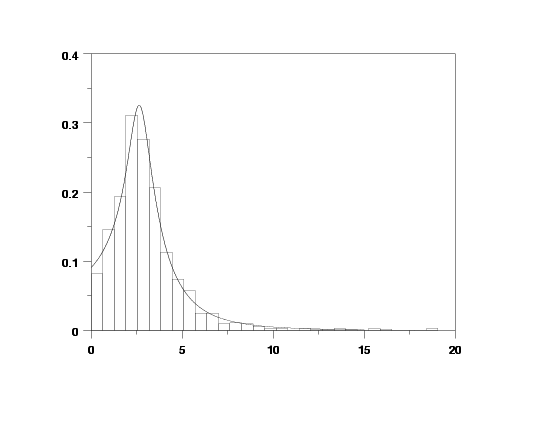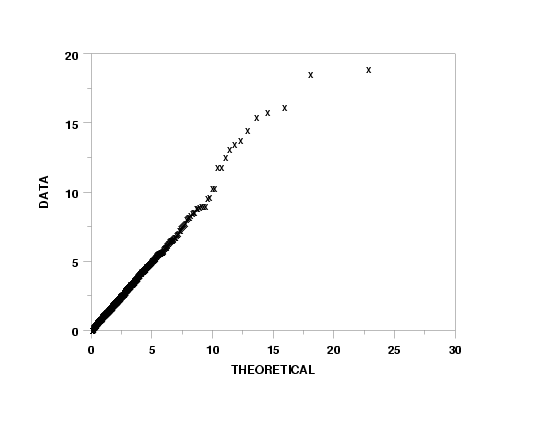

|
WAKPDFName:

where U is a standard uniform random variable. That is, the above equation defines the percent point function for the Wakeby distribution.
The parameters
The following restrictions apply to the parameters of this distribution:
The domain of the Wakeby distribution is
With three shape parameters, the Wakeby distribution can model a wide variety of shapes. The cumulative distribution function is computed by numerically inverting the percent point function given above. The probability density function is then found by using the following relation (given on page 46 of Johnson, Kotz, and Balakrishnan):

where F is the cumulative distribution function and
 + +

<SUBSET/EXCEPT/FOR qualification> where <x> is a number, parameter, or variable; <y> is a variable or a parameter (depending on what <x> is) where the computed Wakeby pdf value is stored; <beta> is a number, parameter, or variable that specifies the first shape parameter; <gamma> is a number, parameter, or variable that specifies the second shape parameter; <delta> is a number, parameter, or variable that specifies the third shape parameter; <chi> is a number, parameter, or variable that specifies the location parameter; <alpha> is a number, parameter, or variable that specifies the scale parameter; and where the <SUBSET/EXCEPT/FOR qualification> is optional. If <xi> and <alpha> are omitted, they default to 0 and 1, respectively.
LET A = WAKPDF(13,2.5,6,0,10) PLOT WAKPDF(X,2.5,6) FOR X = -10 0.1 10
LET GAMMA = <value> LET DELTA = <value> LET ALPHA = <value> LET Y = WAKEBY RANDOM NUMBERS FOR I = 1 1 N WAKEBY PROBABILITY PLOT Y WAKEBY PROBABILITY PLOT Y2 X2 WAKEBY PROBABILITY PLOT Y3 XLOW XHIGH WAKEBY KOLMOGOROV SMIRNOV GOODNESS OF FIT Y WAKEBY CHI-SQUARE GOODNESS OF FIT Y2 X2 WAKEBY CHI-SQUARE GOODNESS OF FIT Y3 XLOW XHIGH The parameters of the Wakeby distribution can be estimated by the method of L-moments using the command
Hoskings report and associated Fortran code can be downloaded from the Statlib archive at
J. R. M. Hosking (2000), "Research Report: Fortran Routines for use with the Method of L-Moments", IBM Research Division, T. J. Watson Research Center, Yorktown Heights, NY 10598. Hoskings (1990), "L-moments: Analysis and Estimation of Distribution using Linear Combinations of Order Statistics", Journal of the Royal Statistical Society, Series B, 52, pp. 105-124.
let xi = 0
let alpha = 10
let beta = 5
let gamma = 1
let delta = 0.3
.
plot wakpdf(x,beta,gamma,delta,xi,alpha) for x = .01 .01 15
.
let y = wakeby rand numb for i = 1 1 1000
class lower 0
let a = maximum y
class upper a
relative hist y
limits freeze
pre-erase off
plot wakpdf(x,beta,gamma,delta,xi,alpha) for x = .01 .01 15
limits
pre-erase on
.
let xisv = xi
let alphasv = alpha
let betasv = beta
let gammasv = gamma
let deltasv = delta
.
wakeby mle y
let xi = xilmom
let alpha = alphalmo
let beta = betalmom
let gamma = gammalmo
let delta = deltalmo
.
wakeby kolmogorov smirnov goodness of fit y
.
char x
line blank
y1label Data
x1label Theoretical
wakeby probability plot y


WAKEBY PARAMETER ESTIMATION:
SUMMARY STATISTICS:
NUMBER OF OBSERVATIONS = 1000
SAMPLE MEAN = 3.030319
SAMPLE STANDARD DEVIATION = 2.118746
SAMPLE MINIMUM = 0.3541647E-03
SAMPLE MAXIMUM = 18.92599
L-MOMENTS:
FIRST SAMPLE L-MOMENT = 3.030319
SECOND SAMPLE L-MOMENT = 1.016696
THIRD SAMPLE L-MOMENT = 0.2496878
THIRD SAMPLE L-MOMENT = 0.2474157
THIRD SAMPLE L-MOMENT = 0.1351471
ESTIMATE OF CHI = 0.5204416E-37
ESTIMATE OF ALPHA = 9.342461
ESTIMATE OF BETA = 5.207736
ESTIMATE OF GAMMA = 1.090611
ESTIMATE OF DELTA = 0.2351132
KOLMOGOROV-SMIRNOV GOODNESS-OF-FIT TEST
NULL HYPOTHESIS H0: DISTRIBUTION FITS THE DATA
ALTERNATE HYPOTHESIS HA: DISTRIBUTION DOES NOT FIT THE DATA
DISTRIBUTION: WAKEBY
NUMBER OF OBSERVATIONS = 1000
TEST:
KOLMOGOROV-SMIRNOV TEST STATISTIC = 0.1757836E-01
ALPHA LEVEL CUTOFF CONCLUSION
10% 0.039* ACCEPT H0
0.038**
5% 0.043* ACCEPT H0
0.043**
1% 0.052* ACCEPT H0
0.051**
* - STANDARD LARGE SAMPLE APPROXIMATION ( C/SQRT(N) )
** - MORE ACCURATE LARGE SAMPLE APPROXIMATION ( C/SQRT(N + SQRT(N/10)) )
Date created: 12/17/2007 |